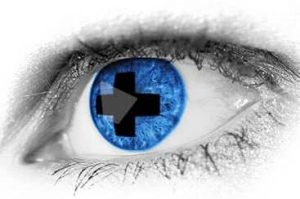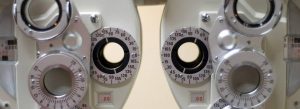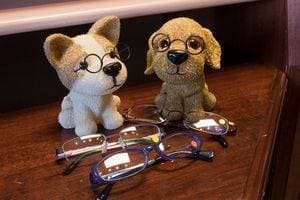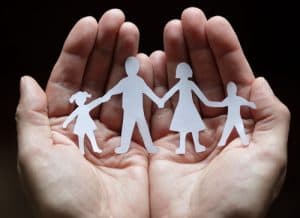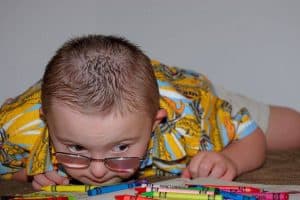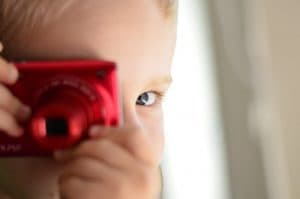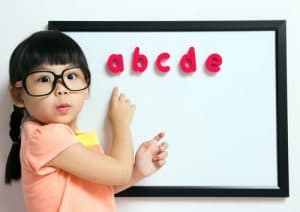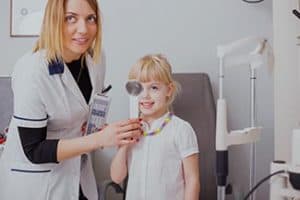How to Protect Your Eyes From Halloween Makeup
Halloween costumes are notorious for heavy makeup and face paint, but did you know that costume makeup contains chemicals and additives that can be potentially
Read MoreBabies and Vision Problems
Babies depend heavily on their vision to explore and learn about the world around them. Many people are unaware that vision, like walking and talking, is a learned ability and your baby’s eyes benefit from visual stimulation. That’s why it’s so important to make sure your child’s eyes and vision are developing normally.
Read MoreDoes my Baby have a Vision Problem?
Infant eye exams are essential to ensure your baby’s visual development meets their developmental milestones. Most baby’s eyes are assessed by a neonatologist within a
Read More2021 Update: Autism (ASD) and Vision
The latest information on autism (ASD) and how optometrists can provide life-changing interventions. Studies of eye clinic records suggest that children with autism (ASD) and
Read MoreTop 5 Pediatric Eye Emergencies
In the United States, approximately 380,000 patients per year are seen by emergency eye doctors. Over 33% are children requiring emergency eye care. While pediatric
Read MoreWhat is Visual Information Processing?
Have you been told your child has difficulties with their Visual Information Processing? How can optometrists help? Visual processing describes the way the brain processes
Read MoreWhat Causes Low Vision In Children?
More than half a million children in North America are blind or have low vision. Having impaired vision makes it difficult to read, play sports,
Read More2021 Update: Vision Therapy for Eye Tracking
Over 30% of those diagnosed as having dyslexia have an eye tracking deficit. When a child has a visual processing or perceptual disorder it hinders
Read More2021 Update: Published Studies in Vision Therapy
Evidence-based medicine integrates academic research with clinical trials — making it the gold standard of published research. Are looking for published research on VT? Provided
Read MoreVision and Autism: Part 1
Author: Randy Schulman, MS, OD, FCOVD This year marks my 30th year as an optometrist and during all of those years I have seen thousands
Read MoreLow Vision In Children
Many children suffer with vision loss, but there are a range of low vision aids that can give them the best chance to engage with the world around them. There are a number of conditions that can cause vision impairments in children. While some of these conditions can be treated in early childhood, many can result in low vision or even total blindness.
Read MoreHow to Help Your Students Succeed
According to the American Optometric Association (AOA), 25 percent of all children have a vision problem significant enough to impact their learning. Up to 80
Read MorePtosis: Why Is My Eyelid Drooping?
What is ptosis? Ptosis, commonly referred to as a droopy eyelid, occurs when the upper eyelid droops down over the eye. A droopy eyelid can
Read MoreAnxiety Activated by Reflex Codes
Author: Dr. Alex and Patti Andrich The Vision Development Team If you frequently experience bouts of anxiety, you are not alone. According to the Anxiety
Read More5 Things Parents Should Know About Visual Development
Author: Dr. Ingryd Lorenzana Brain Vision Institute 1. The brain is the only organ that is not fully developed at birth, and its function builds
Read MoreWhat Is Intermittent Strabismus?
Strabismus, also called an eye turn, can be intermittent or constant— depending on how often it occurs. Intermittent strabismus occurs occasionally, most often during stressful
Read MoreHow Is My Optical Prescription Measured?
Whether you are visiting your eye doctor for your annual checkup, or have noticed that your vision is not as sharp as it used to
Read MoreVision Therapy for Self Confidence: Success Stories
Real life stories of children who struggled with self confidence as a result of an underlying vision problem. *Names have been changed for privacy protection.
Read More7 Signs Your Child Might Have a Lazy Eye
Do you know the signs to look for to identify lazy eye in your child? A lazy eye is generally difficult to recognize because it usually develops in only one eye, without a noticeable eye turn. It is important to be aware of the signs that may indicate a lazy eye, since in most cases, the condition is not recognized easily – though it can significantly affect a child’s quality of life.
Read More8 Tips to Protect Your Child’s Vision
Visual health is crucial for all aspects of life – seeing, learning, and connecting with others. Follow these tips to protect your child’s eyes and developing vision, to give them a life-time of clear vision, good eye health and the best opportunity to succeed in school and the sports field.
Read MoreMyopia Management FAQs
Q1: What is myopia? A: Myopia is a refractive error, or a vision condition that affects the ability to see distant images or objects clearly.
Read MoreOptical and Contact Lenses
Buying your new pair of eyeglasses can be fun. The quality and range of lenses are always increasing. Considering contact lenses or laser surgery?
Read MoreBifocals for Lazy Eye
What are bifocals? Bifocals are glasses that contain two lens prescriptions, one for near vision and one for distance vision. The lens powers are usually
Read MoreVision Therapy for Children
Are your child’s school grades not a true reflection of their potential? Has your child been told they have a learning or attention difficulties?
The problem could be with their eyes or visual skills and vision therapy might the solution you have been looking for.
What Is Farsightedness?
It is estimated that 13% of school age children are far-sighted, farsightedness, also known as long-sightedness or hyperopia, causes near objects or images to appear blurry. Hyperopia causes the eye to focus what you are looking at behind the retina, instead of on the retina- causing words on a page, or images on your phone to appear out of focus.
Read MoreChildren’s Eye Emergencies
What is an eye emergency? An eye emergency is any situation that poses a threat to a child’s eye health or vision. Eye injuries account
Read MoreA Guide to Eye Infections
Up to 1 in 8 of all children will have an eye infection each year. Parents should be aware of the symptoms of an eye infection to enable prompt identification and treatment. Eye infections can be serious and may cause permanent vision loss. Effective treatment is always needed, especially when bacteria, viruses, or fungi invade the eye or the surrounding areas. The most common eye infections that affect children are called Viral and Bacterial Conjunctivitis— both highly contagious.
Read MoreEye Drops For Children
What are eye drops used for in children? Your eye doctor may have used eye drops during the eye exam of your child or may have prescribed eye drops for their use. Eye drops are commonly administered or prescribed by eye doctors for children.
Read MoreConvergence Insufficiency
Convergence Insufficiency (CI) impacts the lives of up to 15% of all students. This is a highly treatable binocular vision condition that affects near vision and eye muscle coordination.
Children with CI can be mislabeled as ‘lazy’, ‘clumsy’, ‘poor students’ and ‘anxious’, or even misdiagnosed with ADHD and dyslexia.
Choosing Glasses for Children
A guide to choosing the best eyeglasses for your child. Eyeglasses for children are now fun, colorful, and available in a wide variety of shapes and sizes. The latest children’s frames are also durable enough to survive the rough and tumble play of today’s child. With so many appealing choices, walking into an optical store can be quite overwhelming … remember to keep this experience as fun and relaxed as possible!
Read MoreAre School Vision Screenings Reliable?
Many schools conduct vision screenings as a service to try to identify vision problems, but are they reliable? The simple answer is, no. These vision screenings are very limited, and are not a substitute for a comprehensive eye examination performed by an eye doctor.
Read MoreFragile X Syndrome
Over half of the Fragile X Syndrome (FXS) population suffer from visual problems – most commonly eye turns, lazy eye and poor eye muscle control. FXS is the second most common chromosomal-based developmental condition after Down Syndrome and is estimated to occur in over 1 in 10,000 children.
Read MoreVision and Sensory Processing Disorder
Have you been told your child has a sensory processing disorder (SPD)? Sensory processing disorders (SPD) can be life-changing, but many eye doctors can now offer you a range of options to best manage your child and allow them to maximize their engagement with the world.
Read MoreVision and Non-Verbal Learning Disorder (NVLD)
Guide to Non-Verbal Learning Disorder (NVLD). NVLD can significantly impact a child’s life, however many eye doctors can provide the solution you have looking for.
Read MoreVision and Gifted Learning Difficulty
Have you been told your child has Gifted Learning Difficulty (GLD)? GLD can be a mystery— how can a child be gifted intellectually, yet still experience learning difficulties? The answer often lies in the diagnosis of a vision problem, most commonly caused by poor visual skills.
Read MoreConvergence Insufficiency and ADHD
This page provides just two of the many research papers that link Convergence Insufficiency (CI) with ADHD. 1. The Relationship Between Convergence Insufficiency and ADHD
Read MoreLazy Eye: Success Stories
Read some real-life stories from patients who have successfully completed vision therapy for lazy eye. *Names have been changed for protection of privacy.
Read MoreHow Does a Traumatic Brain Injury Cause Vision Problems?
Brain injuries can lead to vision problems, especially in children. We often think of a Traumatic Brain Injury (TBI) affecting adults, however consider these facts:
Read MoreWhat Is ADHD?
Attention deficit hyperactivity disorder (ADHD) is one of the most common behavioral disorders among children. ADHD behaviors generally interfere with academic and social success and cause many difficult challenges. Over four million American children – up to 11 percent of school age students – are diagnosed with ADHD.
Read MoreEye Conditions That Cause Strabismus
Many common eye conditions can lead to an eye turn. Eye turns affect over 3 people in 100 and can be successfully treated by eye doctors, often without needing complex eye surgery.
Read MoreA Teacher’s Guide to Vision
As an educator, it may surprise you to discover that many students that show signs of a learning difficulty actually have an undetected vision problem. Teachers play a vital role in the future success of their students and are the most qualified professionals to notice any learning problems in the classroom. “It is estimated that more than ten million school age children suffer from vision problems that may cause them learning difficulties in school.” (National PTA)
Read MoreStrabismus FAQs
Q: Is strabismus surgery the only treatment option for an eye turn? A: No. Strabismus treatment options depend on the type of strabismus— direction of
Read MoreMy Lazy Eye Was Misdiagnosed
“Thanks to Vision Therapy, I Gained 3D Vision!”. A Personal Story by Rachel Cooper, Past Director of the Optometrists Network.
Read MoreParent’s Checklist to Identify a Vision Problem
Is a vision problem impacting your child’s academic success or athletic performance?
Did you know that vision problems affect up to 25 in every 100 children – that’s at least six students in every class.
This checklist can be a useful tool for you to understand all of the behavioral and physical symptoms that your child is experiencing, and may help to facilitate the identification of a vision problem.
How Does Vision Affect Learning?
Since up to 80% of everything a child learns is derived through the visual pathways and their eyes, if there is any interference in their vision, a child may not develop to their maximum potential. There are 17 visual skills that are essential for learning.
Read MoreVision Therapy: Evidence-Based Research
Vision therapy is an evidence-based treatment modality. Do you want to see a list of references for published research articles on vision therapy and its effectiveness? Some of the references are available as links to original published research or complete articles in PDF format.
Read MoreVision and Down Syndrome
The frequency of Down Syndrome (DS) is approximately 1 in every 800 births, with an increased frequency among older mothers. With the specialized improvements in the quality of eye care individuals with DS can live a more productive, longer life. Individuals with Down Syndrome (DS) are at a higher risk for a range of vision conditions that may affect the development of their visual skills.
Read MoreVision and Special Needs
If you are a parent of a special needs child, then by now you have realized that nothing fully prepares you for this unique journey. Public school data in the USA now shows that up to 14 percent of all public school students ages 3 to 21 receive special education services.
Read MoreWhat Is Lazy Eye?
According to research, amblyopia affects up to 1 in 33 of the population— this means up to 10 million people in the U.S. may have a lazy eye. Amblyopia, commonly known as a “lazy eye”, is a neuro-developmental vision condition that begins in early childhood and develops when one eye is unable to achieve normal visual acuity, causing blurry vision in the affected eye, even with corrective eyewear. The condition also commonly presents with poor depth perception, and reading difficulties.
Read MoreDoes My Child Have Dyslexia?
Has your child been diagnosed with Dyslexia? Since up to 80 percent of learning in school is acquired through vision, a child diagnosed with dyslexia may actually have an undiagnosed vision problem, causing difficulties with their academic performance.
Read MoreHow Is Lazy Eye Treated?
A variety of treatment options have been shown to treat lazy eye – the aim is to strengthen the eye-brain connections necessary for binocular vision. Traditionally, it has been thought that lazy eye treatment should begin before a child reaches around eight years old, however recent research shows that even after this age, lazy eye can be successfully treated. That being said, the earlier the condition is diagnosed, the better the treatment outcome will be.
Read MoreWhat Is Exotropia?
Exotropia is a common form of strabismus characterized by an outward eye turn, away from the nose. Exotropia is a eye turn where one eye points outwards, this may be noticed while the child is looking at distance objects, near objects or both.
Read MoreWhat Is Esotropia?
Esotropia is a form of strabismus (crossed-eyes) that is caused by an inward turn of the eye, toward the nose. This condition can be constant or intermittent and cause an individual to appear ‘cross-eyed’.
Read MoreADHD and Vision: Recent Research
Recent research has shown that ADHD behaviors may actually be a result of vision problems. If your child is fidgety, hyperactive, or distressed by his schoolwork, you may think that a diagnosis of ADHD is obvious. In the last 15 years, many clinical trials have been published and show that many vision problems can affect your child in the same way as an attention deficit disorder. Vision problems can be effectively treated, often without medications.
Read MoreEye Exams for Children
Eye doctors utilize specific clinical and diagnostic tools and assessments to determine your child’s eye health and visual abilities. Since many learning skills are dependent on the strength of visual skills such as binocular vision, accurate eye movements, the ability to see distant objects, etc., doctors recommend that children have their first eye exam at age 6 months.
Read MoreVision and Autism (ASD)
Visual problems can have a large impact on the life of a child with austism (ASD). Vision problems are common in children with ASD, but unfortunately these often go undiagnosed.
Read MoreDoes ADHD Cause Social Problems?
Sometimes children with ADHD don’t fully understand what is expected of them in social situations. Children with ADHD usually encounter many obstacles in school, finding it difficult to succeed in their studies. Many children with ADHD face difficulties in reading or math, organization, focus, as well as their attention challenges.
Read MoreCan Vision Problems be Misdiagnosed as ADHD?
While many children with ADHD have 20/20 vision, they may still suffer from vision problems that affect their ability to learn. Functional vision difficulties can produce similar symptoms to those found in ADHD. These visual problems can lead to skipping lines, confusing words and word-order, etc. – making it impossible for the child to read accurately and efficiently.
Read MoreADHD and Vision: Success Stories
Real life stories from parents of children diagnosed with ADHD – when a vision problem was an underlying issue and was successfully managed with a personalized program of vision therapy. *Names have been changed for privacy protection.
Read More



